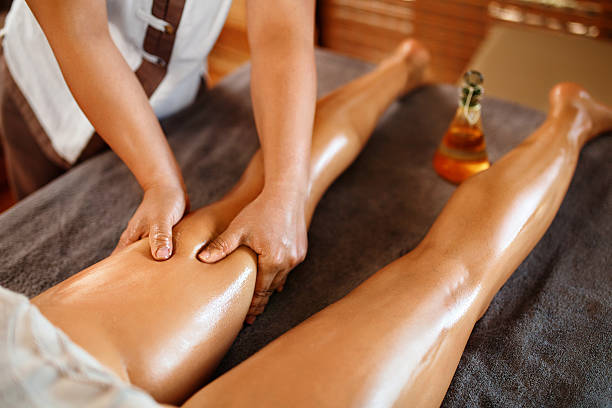Abhyanga is a traditional style of warm oil massage that goes back 5,000 years in India. Abhy=movements & Anga=body. This massage is practiced in Panchakarma Therapy (cellular detoxification protocol), as well as on its own as a nourishing treatment. As we age, our bodies dry out on the inside and outside. Using oil can be a great way to reverse some effects of aging by feeding fats to our cells and deepest layers. Oil is the Earth element and is very grounding and nourishing. In Sanskrit, the word Snehana translates to “oleation”, which also means love. To oil your body is to give it love!
Everything we put on our skin gets absorbed and digested through our epidermis. We usually consume oils and herbs through consumption of food, but we can also consume oil through our skin! Within 35 minutes after application, the oil will reach the deepest tissue layers. There are 7 layers of the skin and each layer correlates to a tissue layer. The tissues are: plasma, blood, muscle, fat, bone, nervous system and reproductive tissue. To bring direct nourishment to these tissues is a gift to the body.
We can use different herbal oils to target pain, nourishment, deep relaxation, anxiety relief, removing excess heat, bringing circulation to the brain, etc. There are many formulas for herbal oils that work for different constitutions and seasons. It is most common to use a sesame oil base in Abhyanga, although coconut and sunflower are used as well. Sesame is warming and is best used for Vata and Kapha doshas. For a strong Pitta case, coconut oil can be used to aid with cooling excess heat. Oil is a carrier; it carries oil & herbs in and toxins out. The absorption of oil through the skin allows the oil to go into the tissues, nourish them and at the same time eliminate impurities from the body. These impurities come out in our sweat and through elimination. It is important to sweat or take a hot shower after an Abhyanga to allow the pores to open up for this purpose.
An Abhyanga is like a smooth dance over the body, with quick-handed movements and symmetry. A lot of oil is used to ensure maximum absorption in all areas. This massage is gentle in comparison to other styles like Swedish or Thai that involve firm pressure and deep tissue work. Abhyanga can provide the same benefits of a Swedish style massage, but it is working from a very different angle. Friction movements are used to get the oil to absorb into the joint areas and tissues. The muscles are squeezed and kneaded, but gently and fluidly with oil. The warm oil is working to give deep relaxation to the body and mind, grounding Vata and bringing us back to Earth.
There is a lymph drainage happening during an Abhyanga as well. The lymph fluid is gently nudged towards the lymph nodes to be cleansed and emptied back into the blood stream. Because the lymph system doesn’t have a pump, lack of stimulation can cause ailments such as swelling and inflammation. Movements in this massage help to bring circulation to the organs and get the lymph moving in the direction for proper detoxification.
Unlike other forms of massage, there is also a breast tissue and stomach section of the Abhyanga. There are so many lymph nodes around the breast tissue and armpits, so it is an important part of the lymph drainage to not skip over. It can also be healing to have the breast tissue acknowledged as an important part of the body. During your own self-abhyanga that you can do at home, this practice can be used to feel for healthy and normal breast tissue.
The stomach part of the massage is very gentle and works with the movement of digestion and apāna vayu (the down & out movement). Massage stimulates the proper pathway of the intestinal movements and helps to move stagnation. The navel is the connection to our mother and it can be deeply healing to fill it with oil. This can address past traumas, or simply and sweetly calm & comfort us.
There are many movements in an Abhyanga that serve the purpose of redirecting Vata dosha in the body. Where there is Vata or air element trapped in the body, there can be pain. Abhyanga works with the 5 subdoshas of Vata, redirecting them to function in their proper seat. These subdoshas are: prāna (downwards & inwards), udana (upwards), samāna (digestion), apāna (down & out), and vyāna (circulation). The combination of these intentional movements and the warm oil is very Vata pacifying. These 5 subdoshas are also called the 5 vayūs and can be worked with during pranayama and yoga.
Although it is beyond relaxing to receive an Abhyanga from a practitioner, it is also important to oil your body often! Here are some simple instructions on how to do a self-abhyanga:
-Warm up your oil (put glass oil bottle in a crockpot of water or bowl of warm water)
-Start by doing a gentle scalp and face massage, doing circular motions on both
-Massage limbs with movements towards the heart and perform circles on the joint areas
-Massage the chest and breast tissue, working toward the heart on the side close to the sternum and towards the armpits on the outer areas
-Massage the belly in clockwise motions (from the perspective of you looking down at your belly)
-Massage the hands and feet
-Leave the oil on for at least 15 minutes and then rinse off in the shower or bath. Avoid using soap to allow the oil to keep moisturizing the skin.
https://santacruzayurveda.com/abhyanga-101-everything-to-know-about-ayurvedic-massage/

Comments
Post a Comment